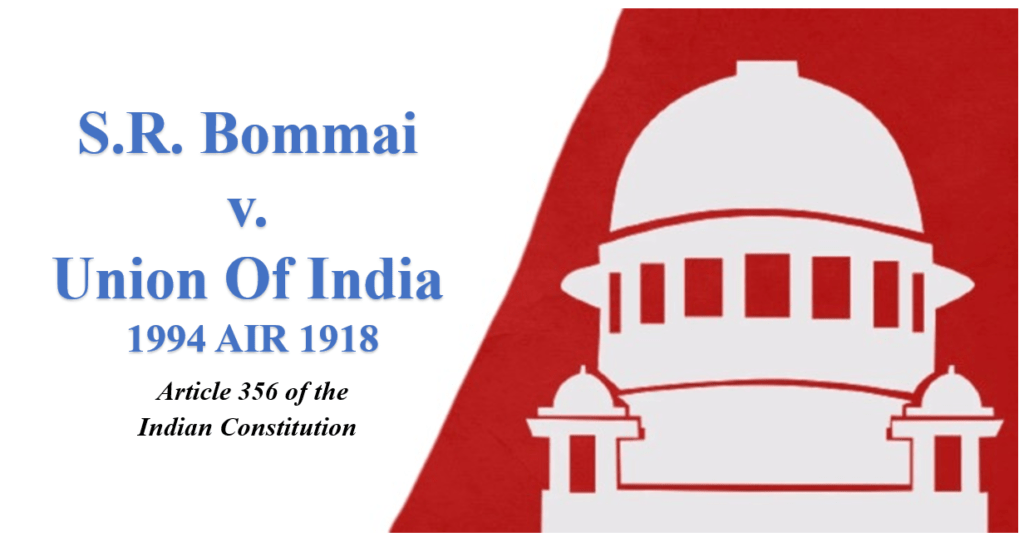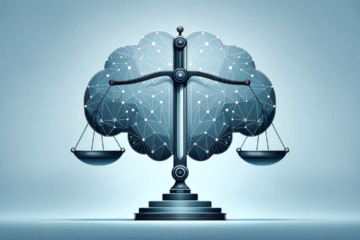
INTRODUCTION
An extremely important and landmark judgement that would go on to change the course of the legal system in India was delivered on March 11, 1994. The case S.R. Bommai v Union of India was decided by the Hon’ble Supreme Court of India by a nine judge Constitutional Bench.
This case is of utmost significance not only for Judges and advocates as an important legal precedent but also for law students when they are studying about the Law of the Land i.e. The Constitution of India. This case depicts the aspirations of the framers of the Constitution and the utopian idea of the legal system which they wanted to achieve. S.R. Bommai v Union of India acts as a step towards that idea as it aims to correct the loopholes surrounding the concept of President’s Rule given under Article 356 of the Indian Constitution.
In this article, I have tried my best to weave an easy explanation for this extremely important case and have made sure that all the questions that could arise in the minds of the readers, ranging from the background, the facts, the issues raised, the contention of the petitioner and the respondent, and the judgement given have been answered in a crisp manner.
BACKGROUND OF THE CASE
The framers of the Constitution, while framing this extremely vast and bulky piece of document, left no stone unturned in making sure that the governance of this newly independent country would be intra vires with the provisions of the Constitution. To achieve this vision for the motherland, they inserted a few articles that they thought would help do this. Article 355 and Article 356 of the Indian Constitution were such articles.
Article 355 states that it is the duty of the Union to protect the Stated against external aggression and internal disturbances.
Article 356 gives powers to the President to establish President’s Rule if in case he gets a report from the Governor of the state or if he himself feels that there is a failure of constitutional machinery in the state i.e. the President may impose his rule in a particular state if he feels that the state government has failed to rule in accordance with the provisions of the Constitution.
Article 356 was inserted in the Indian Constitution with a view that it would be used very sparingly and only in extreme situations. The father of the Indian Constitution, Dr. B.R. Ambedkar, was himself of the opinion that the provisions of this article should only be invoked in very rare cases and that this would remain a dead letter. But this was not followed at all. On the contrary, President’s Rule was imposed as many as eighty three times between the forty year period from 1951 to 1990.
Though this case talks about the President’s Rule that was imposed in Karnataka in the year 1989, a few other states were also under the President’s Rule at around the same time. For instance, Nagaland was under the President’s Rule in August 1988; Meghalaya in October 1991; Madhya Pradesh, Rajasthan and Himachal Pradesh in December 1992.
This case revolves around the state of Karnataka where the Janata Dal party was in power with S.R. Bommai as the Chief Minister of the state. The party ruled from August 1988 to April 1989 before its government was dismissed by the Governor of the State on the ground that the Chief Minister had lost his majority owing to large-scale defections and President’s Rule was imposed in the state under Article 356 of the Indian Constitution. The Governor of the state, P. Venakatasubbaiah, submitted a report to the President stating there are dissensions and defections in the ruling party. The President’s Rule was imposed keeping in view Article 356 of the Indian Constitution which states that the President may establish his rule in a particular state if he gets a report from the Governor of the state or if he himself feels that there is a failure of the constitutional machinery in the state.
S.R. Bommai wanted to prove his majority in the house and he submitted a resolution passed by the Janata Dal Legislature to the Governor for the same but he was denied the opportunity to do so. He filed a writ petition in the Karnataka High Court but his case was dismissed. He eventually moved to the Hon’ble Supreme Court where his case was decided.
LEGAL ISSUES RAISED
- Whether the presidential rule proclaimed under Article 356 is justified?
- Whether the President enjoys unrestricted power to proclaim emergency under Article 356(1)?
- Whether the proclamation comes under the scope of Judicial Review under Article 13?
JUDGEMENT
The Hon’ble Supreme Court interpreted the Article 356 of the Indian Constitution and stated the grounds and prerequisites to be fulfilled before President’s Rule can be imposed in a state. Article 356(1)(a) allows the President to take over the executive powers of the state while Article 356(1)(b) allows the President to declare that the Legislature of the state shall be exercisable by the Parliament. Moreover, the President may make other such incidental and consequential provisions as necessary or desirable for giving effect to the objects of the Proclamation, as stated by Article 356(1)(c). The clause 2 states that this Proclamation can be revoked or varied by a subsequent Proclamation. Article 356(3) states that the said Proclamation (unless it is a Proclamation for revoking an earlier Proclamation) must be passed by both the houses of the Parliament before the expiry of the period of two months since it is introduced. A Proclamation so approved, unless revoked, would cease to exist on the expiration of a period of six months from the issue of such Proclamation.
Moreover, the Supreme Court said that the power of the President under Article 356 is subject to Judicial Review. Article 74(2) which provides protection to the government and states that the advice given by the council of ministers should never be asked to be revealed by courts was interpreted in a broader sense. The Supreme Court said that the courts are not barred from asking for the material on which this advice is based and that would still fall into the purview of Article 74(2) i.e, the court can call the material on the basis of which such decision has been taken as the material behind the satisfaction that President’s Rule is required. Prior to this judgment, the High Courts of various states were interpreting the Article in a narrower sense and their judgements were based on the exemption clause provided under Article 74(2) of the Indian Constitution.
The Court further stated that the President does not have the power to dissolve the Legislative Assembly of the state. The power enshrined to him under Article 356(1)(c) authorises him to just suspend the workings of the Assembly. The dissolution of the Legislative Assembly can be done only after the majority approval of both the Houses of the Parliament. This would ensure that there are checks and balances to the powers vested with the President.
The Sarkaria Commission Report was also thoroughly discussed while delivering the judgement for this case. The Sarkaria Commission was set up by the Central Government in 1983 to examine the centre-state relationships on various aspects and also to suggest amendments within the framework of the Indian Constitution. The Court endorsed the report of 1988 which states that the President should first give warnings to the state which has failed to act according to the provisions of the Constitution of India instead of directly exercising his powers under Article 356(1). In addition, when the ruling party has failed to prove its majority, the Governor should invite other parties to prove their majority in the house instead of directly calling upon the President to establish his rule in the state.
The Supreme Court discussed the Basic Structure Doctrine which states that the basic structure of the Constitution i.e, the foundations on which the Indian Constitution is based on, should always be followed, irrespective of the situation. The basic feature of Federalism was called for discussion in this case. The Indian Constitution is federal in character and even though it gives more powers to the central government, the Supreme Court concluded that the states should be given adequate powers to rule in their sphere and they should not be interfered with in this regard.
Hence, as a result, the Supreme Court declared the President’s Rule established in Karnataka as unconstitutional and restored the state government in the state.
CONCLUSION
This case went on to become a landmark decision in regards to the centre-state relations. S.R. Bommai v Union of India acts as an important testimony for the fact that even though the centre has more power than the states, it cannot arbitrarily impose its powers on the state. The Court kept in mind the Basic Structure Doctrine and established that the states are supreme in their respective political arenas. This case also threw light on the blatant misuse of the Article 356 and the ever so frequent imposition of the President’s Rule and declared that to be unjustified.
This case acts as an important one in the area of the Constitution of India and is used as principal legal precent widely used by judges and advocates while dealing with current cases of the Constitution.
Written by: Vaanika Singhal, Dr. B.R. Ambedkar National Law University, Sonepat




0 Comments